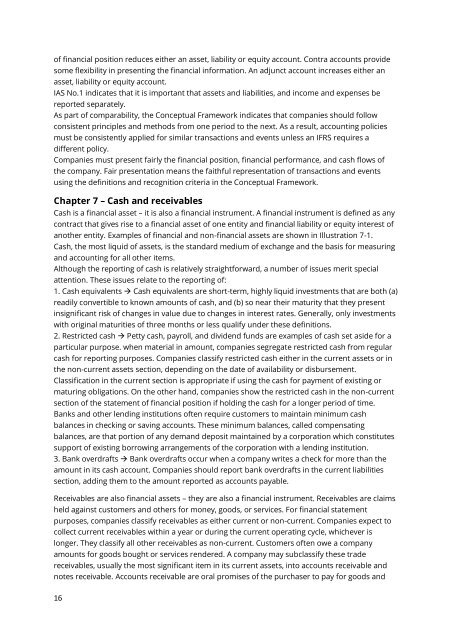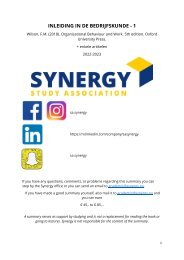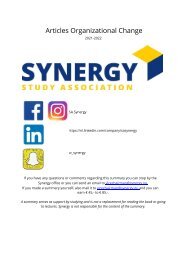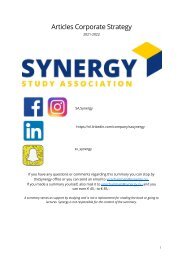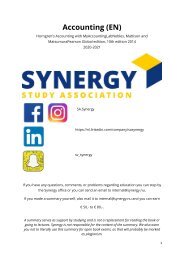Create successful ePaper yourself
Turn your PDF publications into a flip-book with our unique Google optimized e-Paper software.
of financial position reduces either an asset, liability or equity account. Contra accounts provide<br />
some flexibility in presenting the financial information. An adjunct account increases either an<br />
asset, liability or equity account.<br />
IAS No.1 indicates that it is important that assets <strong>and</strong> liabilities, <strong>and</strong> income <strong>and</strong> expenses be<br />
reported separately.<br />
As part of comparability, the Conceptual Framework indicates that companies should follow<br />
consistent principles <strong>and</strong> methods from one period to the next. As a result, accounting policies<br />
must be consistently applied for similar transactions <strong>and</strong> events unless an IFRS requires a<br />
different policy.<br />
Companies must present fairly the financial position, financial performance, <strong>and</strong> cash flows of<br />
the company. Fair presentation means the faithful representation of transactions <strong>and</strong> events<br />
using the definitions <strong>and</strong> recognition criteria in the Conceptual Framework.<br />
Chapter 7 – Cash <strong>and</strong> receivables<br />
Cash is a financial asset – it is also a financial instrument. A financial instrument is defined as any<br />
contract that gives rise to a financial asset of one entity <strong>and</strong> financial liability or equity interest of<br />
another entity. Examples of financial <strong>and</strong> non-financial assets are shown in Illustration 7-1.<br />
Cash, the most liquid of assets, is the st<strong>and</strong>ard medium of exchange <strong>and</strong> the basis for measuring<br />
<strong>and</strong> accounting for all other items.<br />
Although the reporting of cash is relatively straightforward, a number of issues merit special<br />
attention. These issues relate to the reporting of:<br />
1. Cash equivalents → Cash equivalents are short-term, highly liquid investments that are both (a)<br />
readily convertible to known amounts of cash, <strong>and</strong> (b) so near their maturity that they present<br />
insignificant risk of changes in value due to changes in interest rates. Generally, only investments<br />
with original maturities of three months or less qualify under these definitions.<br />
2. Restricted cash → Petty cash, payroll, <strong>and</strong> dividend funds are examples of cash set aside for a<br />
particular purpose. when material in amount, companies segregate restricted cash from regular<br />
cash for reporting purposes. Companies classify restricted cash either in the current assets or in<br />
the non-current assets section, depending on the date of availability or disbursement.<br />
Classification in the current section is appropriate if using the cash for payment of existing or<br />
maturing obligations. On the other h<strong>and</strong>, companies show the restricted cash in the non-current<br />
section of the statement of financial position if holding the cash for a longer period of time.<br />
Banks <strong>and</strong> other lending institutions often require customers to maintain minimum cash<br />
balances in checking or saving accounts. These minimum balances, called compensating<br />
balances, are that portion of any dem<strong>and</strong> deposit maintained by a corporation which constitutes<br />
support of existing borrowing arrangements of the corporation with a lending institution.<br />
3. Bank overdrafts → Bank overdrafts occur when a company writes a check for more than the<br />
amount in its cash account. Companies should report bank overdrafts in the current liabilities<br />
section, adding them to the amount reported as accounts payable.<br />
Receivables are also financial assets – they are also a financial instrument. Receivables are claims<br />
held against customers <strong>and</strong> others for money, goods, or services. For financial statement<br />
purposes, companies classify receivables as either current or non-current. Companies expect to<br />
collect current receivables within a year or during the current operating cycle, whichever is<br />
longer. They classify all other receivables as non-current. Customers often owe a company<br />
amounts for goods bought or services rendered. A company may subclassify these trade<br />
receivables, usually the most significant item in its current assets, into accounts receivable <strong>and</strong><br />
notes receivable. Accounts receivable are oral promises of the purchaser to pay for goods <strong>and</strong><br />
16


